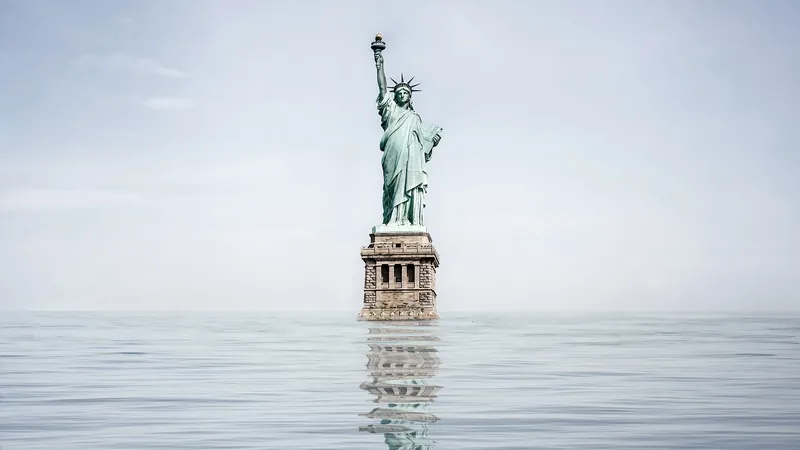
Is New York City Facing a Future Underwater? Insights from Ancient Ice Sheets Suggest Yes!
2025-04-22
Author: Wai
On October 29, 2012, Superstorm Sandy wreaked havoc on New York City, unleashing a staggering 14-foot tidal surge that demonstrated the destructive potential of rising sea levels. The storm claimed 147 lives and caused a $50 billion blow to the economy, but it also opened a stark window into the future.
Fast forward to mid-century: flood events like Sandy could shift from rare occurrences to routine events, plunging low-lying territories such as Ellis Island beneath the waves. By 2100, projections show we might see sea levels rise by as much as 9.5 feet—critical levels that could forever alter the landscape of NYC.
Lessons from Ancient Ice Sheets: The Hidden Truth About Sea-Level Rise
Remarkably, evidence from Earth’s climatic history indicates that these forecasts might be not just true but perhaps overly cautious. During the Last Interglacial period, which occurred roughly 129,000 to 116,000 years ago, temperatures soared by as much as 3.6°F above preindustrial levels—similar to today’s rising temperatures. A critical aspect of this era was the shifting dynamics of ancient ice sheets, particularly the Laurentide Ice Sheet, which may have persisted longer than previously believed. This upended conventional theories on how much ice melted, suggesting that Antarctica may have shed ice more rapidly than we thought.
Evolving Sea-Level Predictions
Since 1880, global sea levels have risen nearly one foot, with projections indicating they could gain another quarter-meter by 2100 due to the acceleration of polar melt. However, determining how much of the polar ice will disappear remains exceedingly complicated, akin to forecasting a storm's path without a reliable roadmap.
Researchers such as Andrea Dutton from the University of Wisconsin-Madison have been peeling back the layers of history, studying ancient coral reefs to reconstruct how sea levels fluctuated during this Last Interglacial period. Instead of a smooth and uniform sea-level rise, Dutton's findings indicate a complex mosaic: sea levels increased unevenly, rising dramatically in some regions while falling in others. This disparity is rooted in factors like land uplift and shifting gravitational forces, complicating our understanding of just how far and fast seas may rise globally.
The Long-Lived Laurentide: A Game Changer
The newly uncovered resilience of the Laurentide Ice Sheet adds yet another layer to this complexity. Research has unveiled that this massive ice sheet didn’t simply vanish early during the Last Interglacial, as previously thought. Instead, it remained significantly longer, exerting its influence on regional sea levels and potentially masking the rapid melting of Antarctica.
Recent sediment studies provide a clearer picture, unveiling that the Laurentide existed until around 122,000 years ago—challenging existing models and reinforcing the idea that Antarctica might soon melt far faster than anticipated.
Anticipating the Future: NYC's Waterlogged Prospects
If recent findings are any indication, New York City could be staring down the barrel of catastrophic sea-level rises, far exceeding previous estimates. While global projections predict approximately 6 feet of rise by 2100, NYC might experience a staggering 10-foot increase, submerging crucial areas such as Lower Manhattan and Coney Island under seawater.
A Wake-Up Call for Urban Planning
The clock is ticking, and experts like Klaus Jacob urge immediate action rather than complacency. He advocates for a triad of responses: protection through barriers, adaptive architectural designs, and strategic relocation from vulnerable coastal areas. The decision is stark—New York needs to either invest significantly in coastal defenses or prepare for mass relocation, as sticking to low-lying regions may spell chaos without a plan.
So, is New York City destined to be a future Atlantis? With the evidence mounting, the urgency for climate-conscious planning has never been greater. Ignoring history's lessons could lead to drowning in the very waves that shaped its iconic skyline.

 Brasil (PT)
Brasil (PT)
 Canada (EN)
Canada (EN)
 Chile (ES)
Chile (ES)
 Česko (CS)
Česko (CS)
 대한민국 (KO)
대한민국 (KO)
 España (ES)
España (ES)
 France (FR)
France (FR)
 Hong Kong (EN)
Hong Kong (EN)
 Italia (IT)
Italia (IT)
 日本 (JA)
日本 (JA)
 Magyarország (HU)
Magyarország (HU)
 Norge (NO)
Norge (NO)
 Polska (PL)
Polska (PL)
 Schweiz (DE)
Schweiz (DE)
 Singapore (EN)
Singapore (EN)
 Sverige (SV)
Sverige (SV)
 Suomi (FI)
Suomi (FI)
 Türkiye (TR)
Türkiye (TR)
 الإمارات العربية المتحدة (AR)
الإمارات العربية المتحدة (AR)